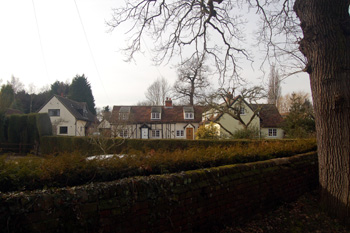
The Barracks - March 2010
In 1910 a thorough rating valuation was carried out across England as part of David Lloyd-George’s pioneering 1909 budget. The survey was so thorough it was known colloquially as the Domesday Survey. The results show that all the older buildings in Northill were owned by John Edmund Audley Harvey, who, though he lived in London, was Lord of the Manor of Manor of Northill as well as Lord of the Manor of Ickwell and owner of Ickwell Bury. These buildings may have been built by a former Lord of the Manor or bought by the Manor at a later stage – detailed research of the Harvey [HY] archive would be needed to try to establish this in each case, unless the current owners still have the deeds to the properties concerned and so can research the history for themselves.
This row of cottages was listed by the former Department of Environment in March 1985 as Grade II, of special interest. The department dated the row to the late 18th (Numbers 13 and 15) and 19th (Number 17) centuries. The houses are of timber framed construction with colour washed brick infill, and colour washed brick. Each has a clay tiled roof, one storey and attics. On older Ordnance Survey maps the properties are named “The Barracks”. Bedfordshire and Luton Archives and Records Service has no record detailing why this name was applied but there is one intriguing possibility.
Volume 71 produced by Bedfordshire Historical Records Society, in 1992, was Bedfordshire Muster Rolls 1539-1831 by Nigel Lutt. Inside is a roll of the Bedfordshire Horse Artillery and its history is explained thus: “The failure of the short-lived Peace of Amiens signed in March 1802 and the renewal of hostilities [with France] in 1803 gave fresh impetus to the volunteer movement. One of the units formed was the Bedfordshire Dismounted Horse Artillery commanded in Major John Harvey of Northill. It was originally called the Bedfordshire Horse Artillery, but never obtained any horses. In 1805 the unit was attached to the 2nd battalion of the Bedfordshire Volunteers commanded by Lieutenant-Colonel Francis Pym of Sandy and articles of enrolment were drawn up for the better regulating and disciplining of the corps. In 1809 the volunteers were disbanded and the men of the Dismounted Horse Artillery joined the Local Militia raised in February of that year as militia reserves”. This raises the possibility that the cottages may have been used as a meeting place for the officers of the unit as John Harvey was Lord of the Manor. He was born in 1772 and so would have been 31 when he formed the wonderfully named Dismounted Horse Artillery. He lived to see napoleon finally defeated at Waterloo in 1815 but was killed in a fall from his horse in Sussex in 1819.
The Rating and Valuation Act 1925 specified that every building and piece of land in the country was to be assessed to determine its rateable value. Northill was assessed in 1927 and the valuer visiting 13 to 17 Bedford Road, then numbered 3 to 7, found that the cottages were owned by Wilfred Course, who lived at 9 Bedford Road [now Number 19]. Clearly at some point between 1910 and 1927 the Harvey family had sold the properties though Bedfordshire and Luton Archives and Records Service has no documents to show whether this was by auction or by private treaty.
Number 3 (now Number 13) [DV1/C44/124] was vacant and stood in nearly half an acre. Accommodation comprised a living room, kitchen and pantry with two bedrooms above. A barn, an earth closet and a washhouse lay outside along with the large garden. Water came from an outside tap.
Number 5 (now Number 15) [DV1/C44/123] was occupied by Charles Stanton who paid rent of £6/7/- per annum, which had been set in 1914. Accommodation (“good”) comprised a living room, kitchen and pantry with two bedrooms above. A barn and earth closet stood outside. The garden was as large as that at Number 3 and water also came from an outside tap.
Number 7 (now Number 17) [DV1/C44/122] was occupied by George Stokes who paid £6/10/- per annum, a rent set in 1920 (it had previously been £4/10/-). He was shown as an occupier in the 1910 Domesday Survey (the occupiers of the other two properties are, sadly, not listed). Accommodation comprised a living room, kitchen and scullery combined with two bedrooms above. The grounds were the same size as the two neighbouring cottages and contained a barn and earth closet as well as the tap for getting water.